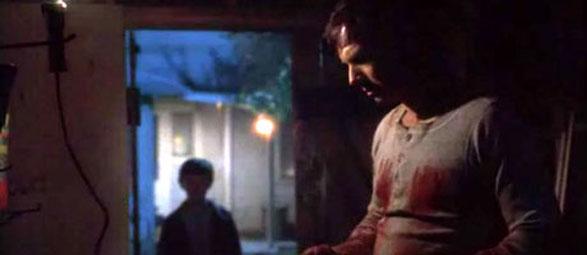
Frailty (Movie Review)
How did two of the most brotastic of catchphrase artists in action-comedies come together to make a stark, seriously grim horror film? Surely Bill Paxton and Matthew McConaughey must have took one look at each other and decided the cumulative power of their screen presences would culminate in either an all night rager complete with windsurfing through the desert or a finely crafted, well acted, audacious flick. Luckily the quiet, slow burning screenplay by writer Brent Hanley and Paxton’s carefully deliberate, nicely paced direction kept the former at bay and gave rise to one of the more memorable horror films of the last decade.
“Fraility” is a multi-layered film that juggles the supernatural, religion, morality, and just a touch of Freudian masculine violence. Set in the present and 1979 east Texas, the film opens with a title montage of newspaper clippings detailing the gruesome accounts of the “God’s Hand” serial killer who has been terrorizing the region. Beginning in present day Dallas, Fenton Meiks (McConaughey) claims his brother Adam to be the perpetrator. Fenton convinces case lead FBI agent Doyle (Powers Boothe) that he knows the location of the victims’ bodies. Doyle escorts Fenton to his hometown of Thurman, Texas where he believes the bodies to be buried in a nearby rose garden. It is during this excursion that Fenton divulges a traumatic series of events that unfolded in his adolescence.
The film then shifts to 1979 Thurman as Fenton narrates his memories. The boys had lived with their widower father (Paxton, credited as Dad) for a number of years in normalcy. Until one night Dad claims to have been visited by an angel who tasks the family with “destroying demons” in preparation for Armageddon. While Adam, the younger, is eager to believe their special place in the world—Dad tells him they are a “family of superheroes”—Fenton is more skeptical. Dad is given weapons and tools for carrying out their mission: a pair of gloves, lead pipe, and an axe. Next another vision prompts him to make a list of the first set of demons they must destroy. But the danger does not become apparent until Dad brings home the first “demon”, who strangely looks like a young woman. Fenton is forced to choose between remaining loyal to his brother, enduring the violence that surrounds him, and running away. It’s more than a little like Larry Cohen’s “God Told Me To” except on a smaller scale and way less camp.
It is impossible to have a discussion of “Fraility’s” merits without revealing some pretty big spoilers. So if you want to go in fresh—I recommend you do—skip to the last paragraph.
For nearly the entire film we experience this past from Fenton’s perspective. The horror in these moments is predicated upon our willingness to accept Fenton’s recollection of these passed events and that we subsequently also see Dad as insane. The violence enacted by Dad on those he kidnaps is presented as shocking and psychologically abusive to his children. Fenton’s doubts concerning Dad’s sanity are reinforced in the way Dad’s visions are presented to us. The underbody of a car transforms into a church ceiling. The sun shines on an abandoned barn. A trophy glows white. The fact these are occurring through everyday items and events implies Dad is searching for some meaning without necessarily really seeing anything. The film’s somewhat flat depth, muted colored scheme, and careful, unobtrusive framing speak to the prowess with which Paxton is capable of building an atmosphere of dread without making the domestic setting a veritable free-for all of grainy images, high contrast lighting, and tinting tricks that seem to have taken over. This understated aesthetic assists in showing Dad as the central threat to Fenton and Adam.
However, at the climax of the film present day Fenton reveals that he is, in fact, Adam, sent by God to “destroy” Doyle. What’s more, we are asked to believe that the people murdered by Dad earlier in the film actually were demons—or at least violent criminals. An additional supernatural element is introduced when it seems that all evidence of Adam’s visit with Doyle is suddenly missing or altered. The film ends with Adam, now a local sheriff, standing outside of a police station with his pregnant wife. As an ominous score plays in the soundtrack Adam states, “God’s will has been served.”
It’s an extremely cynical ending that asks us to posit “God” as a vengeful, ruthless being who keeps us bound by the tyranny of violence. The fact that this important information concerning the validity of Dad’s actions is concealed until the film’s conclusion directly impacts how we apprehend the horror. By experiencing Dad and Adam’s actions without this lens, we are capable of seeing violence done in the name of morality just as horrific as violence done with malicious intent. Then, by positioning Adam in the final shot as symbolic of a particular social, spiritual, and patriarchal authority, the film works to underline the potential monstrous impulses throughout a wide range of dominant institutions. Instead of the film being a pseudo-Christian parable of righteous, spiritual violence enacted by government authority we are asked to see this violence as equally vicious.
But the strategy of this reveal also implies that as people, criminals are beyond contrition. At times “Frailty” is a touch too bogged down in getting the mechanics of its tricks nailed down to really consider what the outcome of the final reveal means for the audience’s perception of the flashback narrative. “Frailty” does not try and push a specific set of moralism on its audience. A “good” person is never defined by particular codes of behavior. However, the fact the film does not elaborate on this essentializes right and wrong, implying that there is no gray area or space for conversation. Rather, “Frailty” sees in religion a source of horror but it also says violence is inherent in humanity. Its both a radically humanist and misanthropic piece of cinema.

